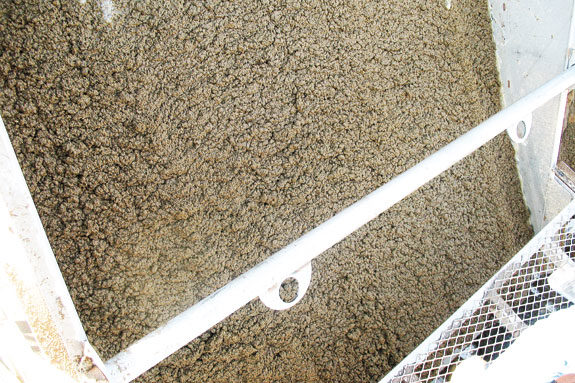All it took was a whack of a broom, and a new concept was born. Perhaps it was a moment of frustration or the thought of trying something different, but when Rejean Houle, president of U.S. Farm Systems, and his colleagues were trying to rid manure build-up from a separation screen, they found an easier way to get the job done. They struck the screen with the end of a broom and watched as the vibrations sifted the solid material off the top of the screen.
Those vibrations led Houle to develop the ScreenTech Vibrator. It is a small, motorized vibration device that attaches to a separation screen, improving performance and reducing labor.
The vibration unit is mounted to a flat 2-inch piece of channel. Six legs are used to connect the channel to the screen so it does not interfere with the movement of the water along the screen. Everything is made of stainless steel, and the motor is fully enclosed.

The motor operates at 360 rpm, which creates 60 vibrations per second.
“With vibration like this, you don’t destroy the screen,” Houle says.
The screens are part of the company’s two-stage separation system. The first stage uses a screen with .030-inch openings to remove the coarser particulate matter. A smaller screen with .010-inch openings then removes the finer particles.
Whether it is a lot of sand, a thicker mix of solids or a pump pushing materials faster than usual, the consistency of manure flowing over the screens can certainly vary.
It can be easy for a screen to get overloaded. When that happens, the water will no longer seep through.
“By using vibration, we kept the slots open,” Houle says, noting it improves the performance of the screens.
“You can watch [the vibrator] work, then stop it and see the build-up that immediately occurs,” he says.
By constantly shaking material off the screen, the vibrator also saves time spent washing the screens.
According to Houle, without the vibration unit the screens must be washed once a day to maintain working order. With the vibration, the screens need only be washed once a week.
That is how often the screens are power-washed on Dan Deruyter’s dairy in Outlook, Washington. He has the system, with the vibrator, installed behind the anaerobic digester on his 5,000-cow Holstein dairy.
Deruyter purchased it to clean up the lagoons by removing more of the solids from the liquids. He sees this happening with the .010-inch screen, but says that wouldn’t be possible without the vibrator.
“It keeps the screen clean of the much finer materials,” Deruyter says. “There is no way we could have run these [small screens] without the vibrator.”
“The vibrator makes it where it doesn’t plug up immediately,” he adds.
The screens sift so much water from the manure that he is left with clean lagoons and stackable manure that can be spread on the field.
The vibrator can be purchased as an add-on option to the two-stage system or separately to be attached to an existing screen.
“It can be installed on a lot of existing screens, but not 100 percent of them,” Houle notes.
When ordered with the system, the addition of the vibrator kit is $2,900. To purchase the kit for addition on an existing screen, the cost is $3,900. PD
Contact Houle of U.S. Farm Systems at (800) 811-9462 or (559) 685-0340 .
YOUR RESULTS
Would you benefit from a ScreenTech Vibrator?
The following checklist can be used to determine if this new technology might be a fit for your operation.
1. Do you use screens to separate manure solids from liquids?
2. If not, are you interested in a manure separation system?
3. Does manure on your dairy vary in consistency?
4. Would you like to enhance performance of a separation system?
5. Do you find the build-up of solids on a separation screen frustrating?
6. Are you looking for cleaning liquid storage on your dairy?
7. Do you want to reduce time spent on cleaning equipment?
If you answered yes to five or more of these questions, this technology may be one for you to consider.
Photos courtesy of U.S. Farm Systems.

-
Karen Lee
- Progressive Dairyman Midwest Editor
- Email Karen Lee




